
Juniperus virginiana, also known as eastern redcedar, red cedar, Virginian juniper, eastern juniper, red juniper, and other local names, is a species of juniper native to eastern North America from southeastern Canada to the Gulf of Mexico and east of the Great Plains. Further west it is replaced by the related Juniperus scopulorum and to the southwest by Juniperus ashei.

Cercocarpus, commonly known as mountain mahogany, is a small genus of at least nine species of nitrogen-fixing flowering plants in the rose family, Rosaceae. They are native to the western United States and northern Mexico, where they grow in chaparral and semidesert habitats and climates, often at high altitudes. Several are found in the California chaparral and woodlands ecoregion.
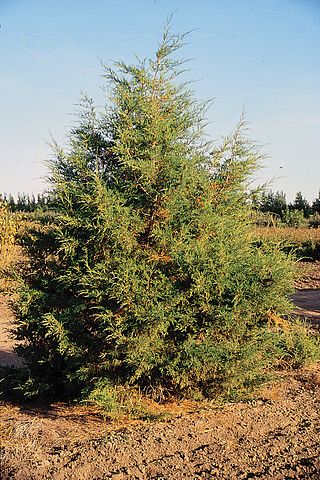
Juniperus scopulorum, the Rocky Mountain juniper, is a species of juniper native to western North America, from southwest Canada to the Great Plains of the United States.

Juniperus deppeana is a small to medium-sized tree reaching 10–15 metres in height. It is native to central and northern Mexico and the southwestern United States.

Cercocarpus ledifolius is a North American species of mountain mahogany known by the common name curl-leaf mountain mahogany. It is widespread across much of the Western United States as well as Baja California in Mexico. It can be found at elevations ranging from 600 to 3,000 m elevation, with the preferred altitude varying depending on the region. It prefers shallow, well-drained soils with a sandy or grainy consistency, and is generally found in areas which receive low annual precipitation (15–26 cm). This makes it common on low mountains and slopes, where it grows in scattered groves among other drought-resistant species such as Pinyon Pines, Junipers and Sagebrush ecosystems.
Juniperus coahuilensis, commonly known as redberry juniper, is a species of conifer in the family Cupressaceae.
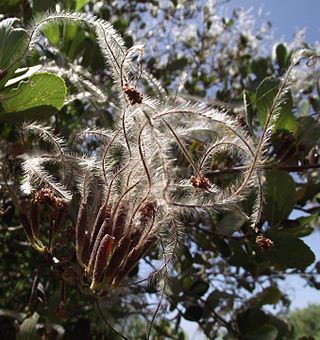
Cercocarpus betuloides is a shrub or small tree in the rose family. Its common names include mountain mahogany and birch leaf mountain mahogany The common name "mahogany" comes from the hardness and color of the wood, although the genus is not a true mahogany.

Cercocarpus ledifolius var. intricatus is a variety of Cercocarpus ledifolius that is commonly known as little-leaf mountain mahogany.
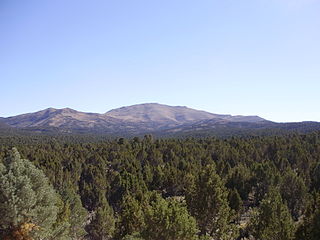
Pinyon–juniper woodland, also spelled piñon–juniper woodland, is a vegetation type (biome) of Western United States higher elevation deserts, characterized by being an open forest dominated by low, bushy, evergreen junipers, pinyon pines, and their associates which vary from region to region. The woodland's density and crown height varies dramatically depending on the site's soil and climate, the age of the stand, and the particular species present, with mature trees ranging in height from as low as 2 meters up to 15 meters. At lower elevations, junipers often predominate and trees are spaced widely, bordering on and mingling with grassland or shrubland. As elevation increases, pinyon pines become common and trees grow closer, forming denser canopies. Historically, pinyon-juniper woodland has provided a vital source of fuel and food for peoples of the American Southwest.

Phoradendron juniperinum is a species of flowering plant in the sandalwood family known by the common name juniper mistletoe. It is native to the southwestern United States and northern Mexico, where it grows in various types of woodland habitat. It has been reported from California, Nevada, Arizona, New Mexico, Oregon, Utah, Texas, Chihuahua and Sonora.
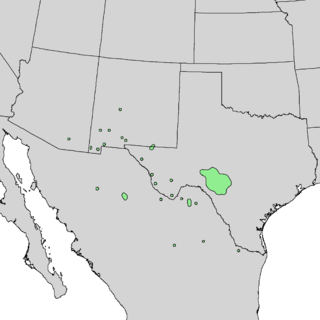
Quercus pungens, commonly known as the sandpaper oak or scrub oak, is a North American species evergreen or sub-evergreen shrub or small tree in the white oak group. There is one recognised variety, Quercus pungens var. vaseyana, the Vasey shin oak. Sandpaper oak hybridizes with gray oak in the Guadalupe Mountains of New Mexico and Texas.

Quercus mohriana, commonly known as the Mohr oak, shin oak or scrub oak, is a North American evergreen shrub or small tree in the white oak group and is native to the south-central United States and north-central Mexico. The species epithet mohriana honors the pharmacist and botanist Charles Mohr of Alabama.

Quercus oblongifolia, commonly known as the Mexican blue oak, Arizona blue oak, Blue live oak or Sonoran blue oak, is an evergreen small tree or large shrub in the white oak group.

Quercus grisea, commonly known as the gray oak, shin oak or scrub oak, is a North American species deciduous or evergreen shrub or medium-sized tree in the white oak group. It is native to the mountains of the southwestern United States and northern Mexico. It hybridises with four other oak species where the ranges overlap, the Arizona white oak (Q. arizonica), the Gambel oak (Q. gambelii), the Mohr oak (Q. mohriana) and the sandpaper oak (Q. pungens).

Fendlera rupicola, commonly known as the cliff fendlerbush or the false mockorange, is a shrub that grows in dry locations in the south central mountain regions of North America.

Mimosa aculeaticarpa is a species of woody shrub in the family Fabaceae. It is commonly known as the catclaw mimosa or the wait-a-minute bush, and is endemic to upland regions of Mexico and the Southwestern United States, particularly Arizona, New Mexico and Texas.

Erigeron rhizomatus is a rare species of flowering plant in the family Asteraceae known by the common names Zuni fleabane and rhizome fleabane. It is native to western New Mexico and eastern Arizona in the United States. It is a federally listed threatened species.
Agastache cusickii is a species of flowering plant in the mint family known by the common name Cusick's giant hyssop. It is native to the northwestern United States from eastern Oregon and central Nevada to Idaho and Montana.

Garrya wrightii is a species of flowering plant in the family Garryaceae known by the common names Wright's silktassel, quinine-bush, coffee berry, bearberry, feverbush, and grayleaf dogwood.
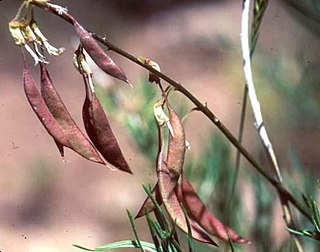
Astragalus ripleyi is a species of flowering plant in the legume family known by the common name Ripley's milkvetch. It is native to southern Colorado and northern New Mexico in the United States.



















